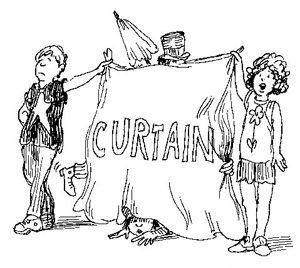|


Many of the activities on these pages may require adult supervision.
Be sure to tell a grown-up about what you're planning and ask for permission before getting started.
All the world's a stage (Shakespeare)
Outdoors
These pages are for the stage manager. You're the one who has to figure out what to do with the space you've got. Let's say the show is going to be outdoors. Where? Is there a spot that lends itself well to seating? Put the audience there. Is there a spot that lends itself to a stage? Put the show there and move the audience.
You can tie a rope between two trees and use it for a curtain in front of the stage. Or you can use the space behind it for an offstage area, the "wings," where people and workers can wait unseen. You don't have to have a curtain in front of the stage. You can change scenery while the audience watches. If your play is outdoors, it makes sense to use the natural setting in the story. You might write the story about a certain magic rock or tree stump.
Indoors
The most natural thing to do indoors is push all the furniture to one end of the room, put chairs in a row, and call the empty space at the other end a stage. This arrangement works well, but there are other arrangements too.
You can arrange the chairs in a circle and have the play go on inside the circle. Leave a space to exit if you need one - you may not. For example, you could start lying down on the floor in the middle of the circle as if you were asleep. At the end of the play, lie back down and go to sleep again. Lights dim. The play has finished.
Props
You can make fancy props or use simple abstract ones. Consider what you might do for a throne. You might decorate a wooden chair with gold crepe paper. Or you might just sit on a carton and get the idea across that it is a throne by the way you act.
You can put signs on things if you want. A lamp can be a tree. Several plants can be a pine forest. A dog can be a ferocious wolf.
Don't have so many props that you get all mixed up using them and end up paying more attention to them than to the role you are playing. The job of the stage director is to make sure that the scenery and the props are interesting to look at and comfortable for those in the play to use.
Changing Scenes 
As was said earlier, you don't have to pull a curtain to hide the changing of scenes. The process can be interesting for the audience to watch. You can have certain mysterious people dressed all in black change the scenes. You can have ghosts change the scenes. You can have one clown change all the scenes. You can even have the actors in the play change their
own scenes around.
If the scene change takes a long time, have someone play an instrument or sing a song while it is going on.
In the picture to the right, two Superkids run onstage and hold up a sheet every time a scene or costume change is necessary.
Click here for LIGHTING
Click here for MORE IDEAS!
|

